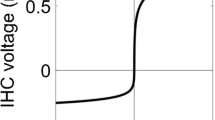Abstract.
Auditory perception neurons, also called inner hair cells (IHCs) because of their physical shape, transform the mechanical movements of the basilar membrane into electrical impulses. The impulse coding of the IHC is the main information carrier in the auditory process and is the basis for improvements in cochlear implants as well as for low-rate, high-quality speech processing and compression. This paper compares biologically motivated models (Meddis, Cooke, Payton) with a newly developed model which is transfer function oriented. The new model has only three reservoirs and the parameters can be controlled through five small ROM tables. This model is compared with the often used Meddis model in terms of accuracy, system parameter flexibility, and hardware effort in an FPGA implementation.
Similar content being viewed by others
Author information
Authors and Affiliations
Additional information
Received: 26 March 1997 / Accepted in revised version: 27 May 1997
Rights and permissions
About this article
Cite this article
Meyer-Bäse, U., Scheich, H. Artificial implementation of auditory neurons: A comparison of biologically motivated models and a new transfer function oriented model. Biol Cybern 77, 123–130 (1997). https://doi.org/10.1007/s004220050373
Issue Date:
DOI: https://doi.org/10.1007/s004220050373




